Dee Estuary Birding
Monthly Newsletter...
July 2025
Newsletter
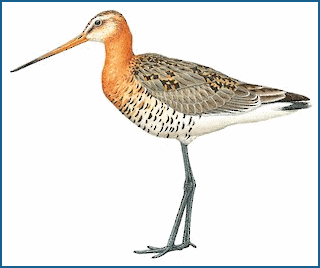
Wetland Bird Survey 2023/24
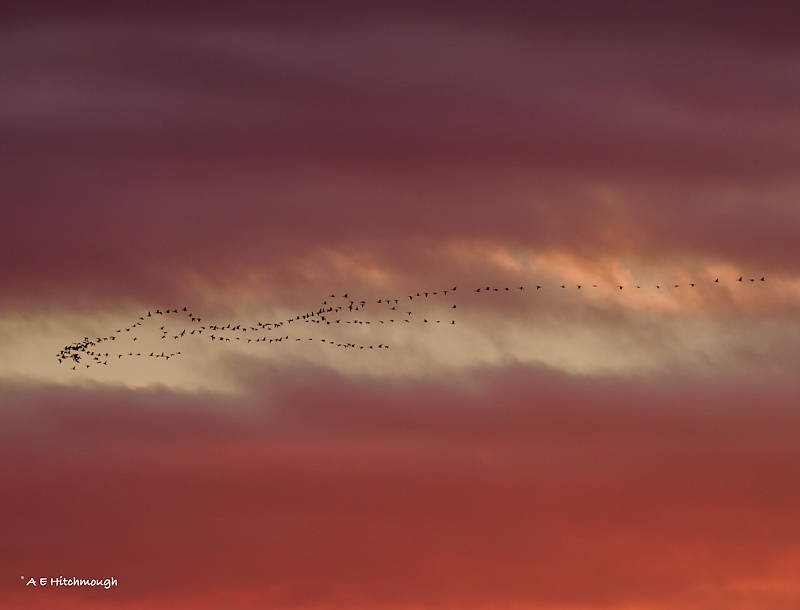
I've been counting waders and wildfowl for WeBS
(Wetland Bird Survey) for nearly 30 years and always look forward to
reading the annual Reports (both for the UK and the local Dee Estuary
report) knowing that I've made a contribution to the data
in them. The 2023/24 season was particularly significant for me because
I had the highest ever single site count of Black-tailed Godwits ever
made on the Dee Estuary which was also one of the highest ever made in
the UK, they were in a field just a short walk from
my house. More about the godwits below.
The WeBS Report is in two parts: 1. a summary report packed full of fascinating articles including five 'Species Focus' articles, discussion of trends, the Goose and Swan Monitoring Programme and Low Tide counts (report available online at https://www.bto.org/sites/default/files/wituk-2023-24-report-bto-jncc-rspb-naturescot.pdf), and 2: a large database updated with the 2023/24 records including site tables and trends for all regular WeBS species (available online at https://app.bto.org/webs-reporting/numbers.jsp).
In
the summary report is an article called 'Largest waterbird
aggregations' and in Table 3 can be seen the total counts for the
principal sites with the Dee Estuary the third most important site in
2023/24, below The Wash and Morecambe Bay and just ahead of the Ribble
Estuary. With three of the top four sites in the UK being in the
North-west it demonstrates just how important our area is for wetland
birds.
Here I briefly summarise the highlights for six species:
Great White Egret
On page 29 of the summary report is an article by
Gill Birtles (BTO) - 'Focus on.... Great White Egret'. I reproduce the
graph below from that article as it neatly demonstrates the phenomonal
increase in numbers nationally over the past 15 years.
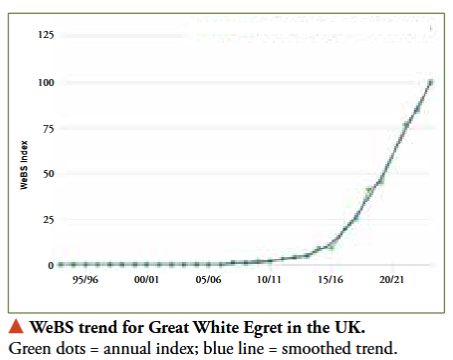
I quote "WeBS data have been pivotal in charting the meteoric rise of Great White Egret numbers since they began colonising the UK. In 2010/11 Great White Egrets were recorded on just 19 sites, with a peak count of five birds on the Somerset Levels. In comparison, in 2023/24, they were recorded on 391 sites with a peak count of 108 on the Somerset Levels."
The max count on the Dee Estuary in 2023/24 was a
record 45, which made it the second most important site in the country
for this species (with Rutland Water which also had a count of 45). As
well as having the highest numbers Somerset Levels is also the main
breeding area and in 2024 they produced 100 fledged young from 54
nests. 2024 saw at least seven other sites with nesting Great White
Egrets, including the Dee Estuary where two nests produced two young.
We know there is much interchange of birds between the Somerset Levels
and the Dee Estuary through colour ringing.
Pink-footed Geese
After a rapid increase nationally between 2011/12
and 2015/16 numbers have shown a small decline over the past eight
years, although still around double they were at the beginning of the
century.
On the Dee Estuary numbers have rapidly increased
since 2009, there was a significant dip in 2022 but 2024 saw another
record count of 23,816 in February. Note that on the Dee Estuary
numbers always peak either in February or March whereas elsewhere peaks
are nearly always in autumn or mid-winter. This is because the large
numbers which winter in north Norfolk (87,075 in December 2023) leave
there during January with many flying west to join us here on the Dee.
In 2023/24 the Dee Estuary was the seventh most
important site in the country for Pink-footed Geese. If the increase of
Pink-footed Geese on the Dee Estuary has been remarkable then the
increase on the Mersey Estuary has been just incredible. Just 397 were
counted here in March 2017 (which, at the time, was regarded as a good
count), yet in March 2024 they had 30,738! For more details about
Pink-footed Geese on the Dee and Mersey Estuaries, and nationally, read
Pink-footed
Geese (October 2023 Newsletter).
Brent Geese
Nearly all the Brent Geese which we see on the Dee Estuary are from the pale-bellied population which breed in north-east Canada with most wintering in Ireland. There has been a big increase in numbers on the Dee Estuary since the beginning of this century and 2023/24 saw a further jump with a record count of 638 in January, and every month between October and April saw monthly records broken. At high tide most birds were counted at West Kirby, and at Walwen Marsh between Greenfield and Bagillt on the Welsh side of the estuary, with smaller numbers off Heswall and at Point of Ayr. Brent Geese are also being seen in increasing numbers at various sites around Anglesey and adjacent mainland sites, and at Morecambe Bay which saw a record 865 in November 2023. It is likely there is much interchange between these sites through the winter.
Ringed Plover
We see two 'populations' of Ringed Plover here on
the Dee Estuary, those that spend the winter here and those on passage.
Over-wintering numbers have been declining here since the beginning of
the century until about seven winters ago since when the five year
average has shown
a welcome upturn. 300 counted in February 2024 was the highest since
1994 when 300 were also present.
Counts of birds on passage are usually much higher but can occur over a short period of time, sometimes just a couple of days and the monthly WeBS counts often miss this peak. But the August 2023 count coincided with the autumn passage with a count of 2,062 - which was the highest count in the country for 2023/24.

Dunlin
I did feature Dunlins in last year's article but as
numbers continue to increase, both on the Dee Estuary and nationally, I
thought it worthwhile mentioning them again.
Dunlin counts reached a peak in the UK in 1996/97 since when they dropped steadily until around 2008/09 when they then stabilised at this lower level before showing an upturn over the past three years. Here on the Dee the peak was later when 41,679 were counted in December 2003. Then we also saw a decrease with counts reaching a low point of 10,553 as recently as November 2019. It's therefore good news that numbers have increased steadily over the past four winters and reached 32,1907 in December 2023, with similar increases nationally.
Our neighbouring estuary, the Mersey, usually has
the largest flocks in the
country but saw a substantial drop in numbers from 66,284 in 2023/24 to
36,036 in 2023/24 - but the birds must have been more dispersed last
winter and nearly all other sites saw increases and the National Index
for 2023/24 is now at the highest level since 2000/01.
Black-tailed Godwit
Numbers of Black-tailed Godwits have been increasing steadily since the 1980s both on the Dee Estuary and Nationally. The counts plateaued out for a few years from around 2012 but appear to be increasing again. There was a record count of 10,422 on the Dee Estuary on August 2023 with 6,350 at the Caldy Wildfowl Collection and 4,000 at Connah's Quay and Oakenholt, and this was the highest count in the country for 2023/24. On a five year moving average the Wash is the most important site and there was a massive count of 16,349 there in August 2022.

© Rchard Smith
Sources of Information
1. Calbrade, N.A., Birtles, G.A., Woodward, I.D., Feather, A., Hiza, B., Caulfield, E., Balmer, D.E., Peck, K., Wotton, S.R., Shaw, J.M., and Frost, T.M. 2025. Waterbirds in the UK 2023/24: The Wetland Bird Survey and Goose & Swan Monitoring Programme. BTO/RSPB/JNCC/NatureScot. Thetford.
2. Neil Friswell and Colin Wells, Dee Estuary and North Wirral Foreshore WeBS Annual Report, 2023/2024.
Note: This article contains Wetland Bird Survey (WeBS) data from Waterbirds in the UK 2023/24 © copyright and database right 2025. WeBS is a partnership jointly funded by the BTO, RSPB and JNCC, with fieldwork conducted by volunteers.
Richard Smith.
Colour Ring Report
Curlew

Red - White(XX)
Ringed at Erde,
Schleswig-Holstein, Germany, on 22/05/2024 as a breeding male.
Recorded at Heswall on 18/06/2024, and again on a very similar date
this year
- 21/06/2025.
The ringer told us that it was recorded back at the ringing site in
April 2025, it was seen displaying several times but appeared not to
have found a mate.
Shelduck

Orange(AM)
Ringed at Seal Sands, Tees Estuary, on 25/05/2024.
Recorded back at Seal Sands in April 2025, then from 09/05/2025 to
14/05/2025 at the Blyth Estuary in Northumberland.2024.
Recorded on Thurstaston Shore on 18/06/2025.
Knots
A flock of Knot has spent June at Burton Mere
Wetlands with between 1,000 and 2,000 present most days. A similar
flock has also been present at Seaforth and we know from looking at the
colour rings that there has been much interchange between the two
sites. Many of these are 2cy birds (i.e. hatched in 2024 and therefore
in non-breeding plumage) but a sizable minority appeared to be 3cy
(i.e. hatched in 2023) and I was fascinated by how much variation in
plumage there was of these birds which were of the same age. For
example, Oflag MCP below, looks like a full summer plumaged adult, yet
Oflag MEV is nearly all grey, and there were birds showing various
intermediate plumages between these extremes. It was also interesting
that a good number of these 3cy birds had chosen not to fly across the
Atlantic with the breeding birds, we know many did cross the Atlantic
as they were recorded by the ringing/colour ringing spotting group
which visited Iceland in May.

Orange flag(MCP)/G
Ringed at Ainsdale on 08/05/2024, aged 2cy.
For a bird ringed as recently as May last year it has been a well
watched bird being recorded a further 33 times since ringing.
It was one of several thousand 2cy birds which spent
the summer of 2024 feeding at Leasowe and roosting at Seaforth, being
recorded several times at both sites from late June to late August. It
then spent the winter at Thurstaston and Meols, last being recorded at
Thurstaston in early April 2025.
This June (2025) it joined the flock at Burton Mere Wetlands being
recorded on the 4th, 9th and 13th.

Orange flag(MEV)/G
Ringed at Ainsdale on 08/05/2024, aged 2cy.
This was another bird which spent the summer of 2024 at Seaforth and
Leasowe, first being recorded at Leasowe on 14/06/2024 with last record
there being late August. It then disappeared with no winter records,
before it turned up at Seaforth on 31/05/2025. It then spent June
flying between Seaforth (recorded 7th, 15th and 22nd) and Burton Mere
Wetlands (recorded 10th and 20th).
In May a total of 90 Orange flagged Knots were
recorded in Iceland where they stop over to feed before their onward
journey to Greenland and Canada. Rose Maciewicz kindly sent us the
records and two birds, which I detail below, caught my eye.
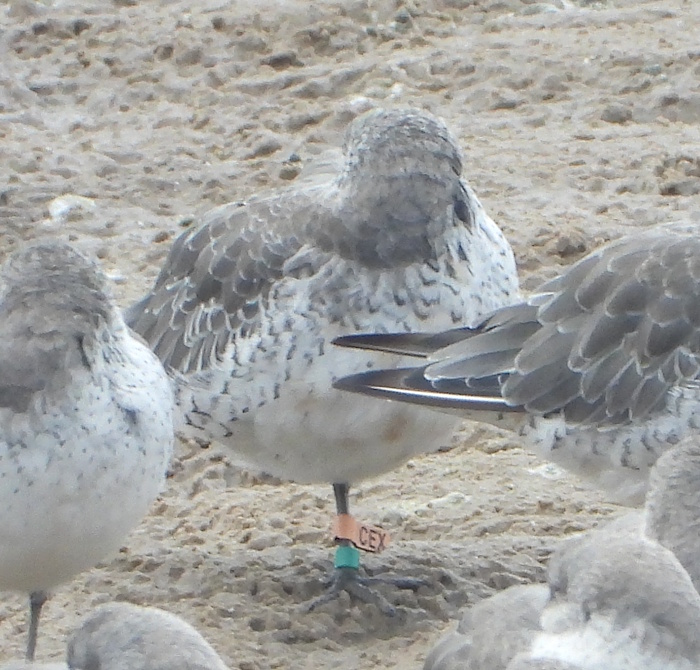
Orange flag(CEX)/G
Caught and fitted with a metal ring just east of Beaumaris
(Anglesey) on 17/01/2010, it was noted that this bird had been hatched
in 2009 - which means this summer (2025) it will be 16 years old, not a
bad age for a Knot.
Lucky for us it was caught again in March 2018 at Altcar when it was
fitted with an orange flag, since when it has been recorded a further
51 times.
Winter records for this bird have been quite sparse but it's presence
near Beaumaris when it was first ringed, and a record from Bangor in
January 2021 hint that it probably spends most of each winter in North
Wales. But what was it doing in Findhorn Bay (just east of Inverness)
in early March 2019? You may think it was starting to move north in
early spring but it was back in Formby in April that spring! And it was
Formby it flew back to the following August after breeding, which it
has done most years.
In 2024 it returned early to Formby, being seen there on July 24th and
we saw quite a lot of CEX in the following months. It spent late summer
and early autumn in the Formby/Seaforth area before moving to Meols in
December where it was seen five times in the low tide roost at Dove
Point through the winter, and also it was seen feeding at West Kirby in
January. There were then no further records until it turned up in SW
Iceland between May 14th and 25th.
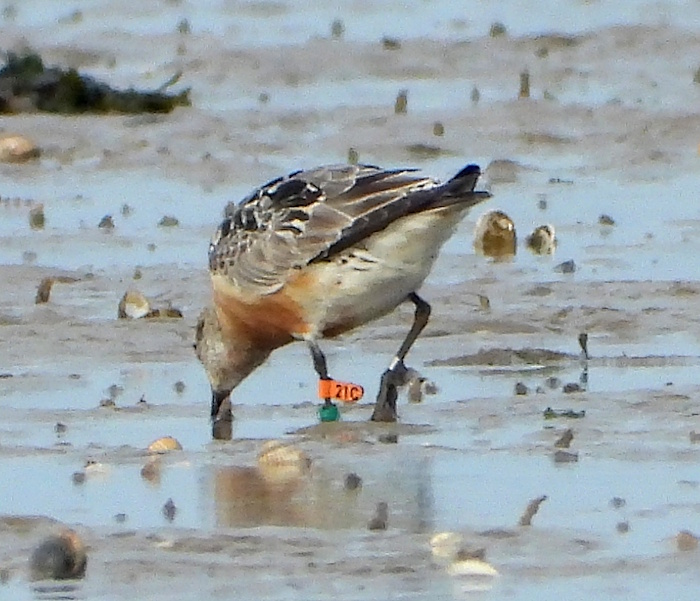
Orange flag(21C)/G
Ringed at Hoylake in November 2022.
There have been 34 records since it was ringed, and, unusually half of
those were in Iceland. When the knots stop off in Iceland most appear
to stay about a week or two around mid-May to feed up before flying on
to breed. Therefore I was intrigued to see that in 2025 21C arrived in
SW Iceland on the early date of May 3rd, when most are still on the
wintering grounds, and was stll there on May 25th, a stay of over three
weeks. It stayed a similar length of time in 2024. Other than that
records have been fairly typical for a Liverpool Bay Knot with
sightings at Meols, Thurstaston, Seaforth, Crosby and Formby.
Colour Rings were recorded by Richard
Smith, Stephen
Hinde and Colin Schofield.
Richard Smith
June Bird News

right: in s/pl © Richard Smith
Up to 2,850 Knots chose to spend the month over-summering at Burton
Mere Wetlands - record numbers for the reserve. It was fascinating
picking out the different plumages - from the 'grey' non-breeding
plumage to full summer breeding plumage - see the Colour Ring Report
above for more details. With the Knots were a couple of Curlew
Sandpipers, one an immature bird and the other in s/pl (photos above).
Also in stunning summer plumage were a few Spotted Redshanks, see photo
below.
Also at Burton Mere Wetlands a pair of Spoonbills are nesting and reported to have three young in the nest. The Common Tern colony at Shotton has 148 pairs breeding, up from the 101 pairs last year but still a long way to go to reach the 400 pairs we used to have before bird flu struck. At Gronant 84 Little Tern nests were counted on the 19th, most with two or three eggs. This is down a bit from recent years as they have had a high amount of crow predation and also some nests were lost due to poor weather conditions at high tide.
Out to sea some fresh westerlies meant quite a few
Manx Shearwaters flew past, max 87 off Red Rocks on the 15th. Several
Mediterranean Gulls had returned by the month end including 10 at
Heswall. The first Black-tailed Godwits arrived back from Iceland on
the early date of the 26th at Caldy and numbers were up to 760 by the month-end.
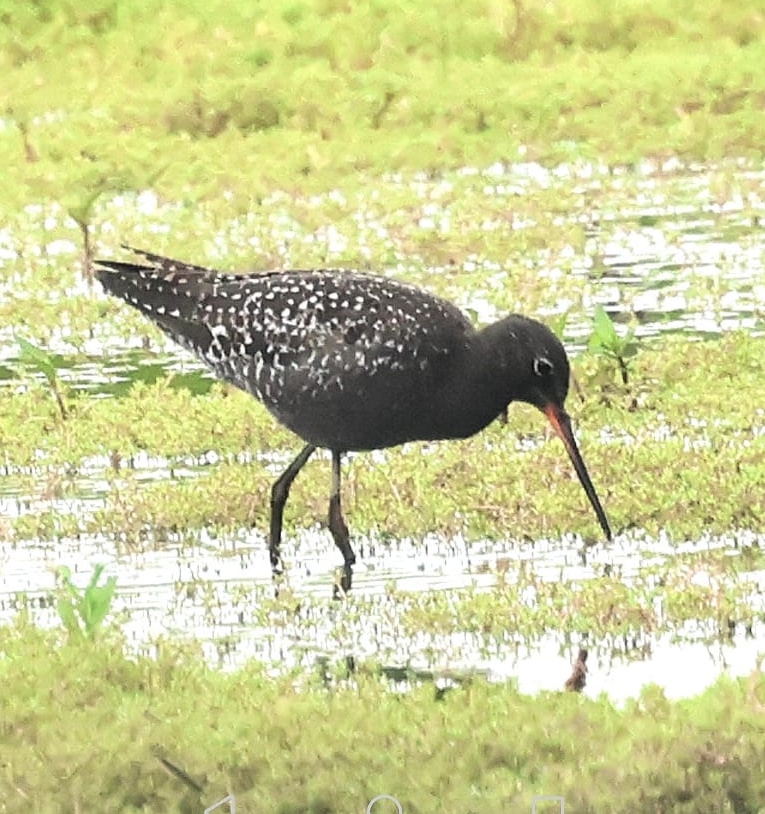
What to expect in July
Lots of birds o the move this month. Sandwich Terns will fill the
estuary with their cries, by the month-end there will be several
hundred at Gronant, West Kirby and Hilbre, hopefully with lots of young
birds. Numbers of Mediterranean Gulls seem to be increasing every year
at the moment and expect to see around 30 at Heswall whilst others can
turn up just about anywhere where there is a gathering of gulls. Little
Gulls are always scarce here but one or two can sometimes be seen among
the Black-headed Gulls off Hoylake and Meols.
Black-tailed Godwits will be returning from Iceland right from the start of the month looking gorgeous in full breeding plumage and both Redshanks and Dunlins will be arriving in their thousands. Common Sandpipers are far less numerous but always great to see, in previous years 20 or 30 have been seen along the River Dee upriver of Connah's Quay.
On the marshes there is likely to be an influx of
both Marsh Harriers and spoonbills, hopefully both will have had a good
breeding season. A strong westerly wind can bring in some good se-birds
including Storm Petrels, Arctic Skuas and Manx Shearwaters.
July Highest
Tides:
25th 12.25hrs (BST) 9.0m
26th 13.00hrs (BST) 9.1m
27th 13.48hrs (BST) 9.0m